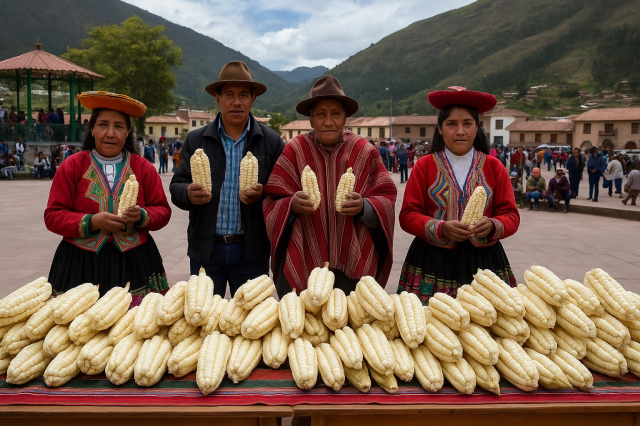Corn, symbol of Andean life
Cusco corn is more than just a food: it's an essential part of the Andean people's identity. Cultivated since pre-Inca times in the fertile valleys of Cusco, this corn with soft, white kernels is considered a symbol of prosperity and fertility . Today, its cultural value is celebrated every year during Corn Week , a festival that combines tradition, music, dance, and local cuisine.
The celebration has its epicenter in the Calca district, in the Sacred Valley of the Incas, where farmers and rural communities gather to pay tribute to corn.
When is Corn Week celebrated?
Corn Week takes place in early November , when corn reaches its peak harvest. For a full week, local residents organize cultural activities, food competitions, agricultural fairs, and artistic performances that highlight the value of corn in Andean culture.
This event is attended not only by local producers but also by national and international visitors drawn by the authenticity of the traditions and the warmth of the Cusco people.
Main activities of the celebration
During Corn Week, you can enjoy numerous activities that reflect the community spirit of the Sacred Valley:
Agricultural Fair: different varieties of corn and derived products such as flour, chicha, and tamales are exhibited.
Best Corn of the Year Contest: Farmers compete to present the largest and tastiest kernel.
Food Festival: Local chefs and families showcase traditional recipes such as choclo con queso (choclo with cheese), humitas (a type of corn cake), and corn cake.
Traditional dance parade: communities from Calca, Pisac, and Urubamba perform their traditional dances in colorful costumes.
Mass and payment to the earth: ancestral ceremony in gratitude to Pachamama for the harvest.
Description: Producers from the Sacred Valley showing corn during the fair.
Alternative text: “Choclo Week in Cusco with producers showing Andean corn.”
The value of corn in Peruvian culture
Corn has been cultivated in the Andes for over 7,000 years. For the Incas, it was a sacred food used in religious rituals and agricultural celebrations. Today, Cusco corn remains a staple on the Peruvian table, pairing with typical dishes such as choclo con queso (corn with cheese), chiriuchu (chicken with cheese), and pachamanca ( pachamanca ).
Furthermore, the Sacred Valley offers unique conditions for its cultivation: fertile soils, a temperate climate, and an ideal altitude for producing large, tender, and sweet beans, recognized even internationally.
Tourism and experiences in Calca
During Corn Week, Calca becomes a meeting point for travelers seeking authentic experiences. Visitors can:
Tour the cornfields and learn about ancient farming techniques.
Participate in traditional cooking workshops where humitas and tamales are prepared.
Enjoy live folk music with local bands.
Visit the Machacancha hot springs , very close to Calca.
Description: Visitors participating in the Corn Week gastronomic festival.
Alternative text: “Tourists enjoying the gastronomic festival during Corn Week in Cusco.”
Economic and cultural impact
Corn Week not only strengthens cultural identity but also boosts the economic development of the Sacred Valley. Farmers can directly sell their products, artisans showcase their work, and local tourism benefits. It is also an opportunity to promote sustainable gastronomy and Andean products , strengthening the communities' economies.
The event also seeks to raise awareness about the importance of preserving native varieties of Peruvian corn , which are part of the country's genetic heritage.
How to get there and tips for attending
For those who wish to experience this, getting to Calca is easy. From Cusco, you can travel by bus or private car, taking approximately an hour and a half . It's recommended to wear light clothing, sunscreen, and a camera to capture the beautiful landscapes of the Sacred Valley.
During the festive week, Calca's main square fills with food stalls, music, and dancing. It's advisable to book accommodation in advance, as tourist demand increases during these dates.
A tradition that lives on
Corn Week is more than a fair: it's an expression of Andean pride and the spiritual connection of the Cusco people to the land. Each ear of corn holds a story of resilience, community, and love for nature. This celebration demonstrates that Peruvian customs live on, passed down from generation to generation.
